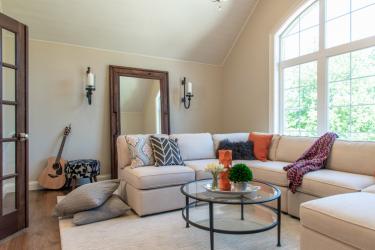With fast-paced, over-stressed and over-scheduled lifestyles becoming the new normal, the pajama lounge, or flex room, is quickly evolving into a necessary space for the modern home. It’s a space where families can gather on a relaxed day off without rushing to get put together for the day.
The look and style of these private retreats is completely open to interpretation and solely dependent on the tastes and lifestyles of the inhabitants. With limitless choices, these tucked-away happy places can function as cozy lounges for adults, quiet study nooks for children and teens, or warmly inviting shared family spaces.
While not a new idea, the second-floor flex space has morphed from leftover loft areas and expanded hallways into its own unique entity. The pajama lounge serves as a private family retreat where children play, watch television or finish homework away from the bustle of the rest of the home. It is unfussy, comfortable and restorative, and neither the room nor those who dwell within need to be gussied up to greet guests.
In today’s modern homes, first-floor master suites are replacing formal living and dining rooms, and as a result, second-floor space is freed up for secondary family rooms. Ideally, these spaces are easily accessible to all family members, sometimes as part of pass-through space — not visible to guests entering the home and easy to close off to create another bedroom or den. Often, the pajama lounge is finished similarly to the main part of house; in some homes, it is even located on the first floor.
The design scheme for a pajama lounge is usually determined by the homeowner but typically calls for plush upholstery, soft lamp lighting and personalized accessories, including family photos and meaningful collectibles.
A space for children generally includes a desk or counter for studying, generous bookshelves and plenty of storage for games and toys. Modern designers even incorporate USB charging stations and other technology into the design or furnishings, always with an eye to flexibility as a family’s needs change over the years.
Far from being wasted space, the pajama lounge turns an under-utilized open area into a favorite family gathering spot, smack-dab in the heart of the home.
Resources
FORNEY + architecture
JE Design Group





